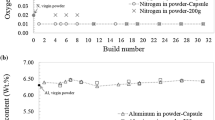Abstract
Low-cost metal additive manufacturing remains difficult but would be of great practical value. To prepare slurry distributed evenly and stably, the present study thoroughly mixed metal powder, as a base material, with corresponding monomers, crosslinking agents, dispersant, initiator, and catalysts. A complex three-dimensional structure of iron powder slurry was built using a pneumatic injection additive manufacturing system. The effects of the injection pressure, platform speed, and nozzle diameter on the width of printed lines were studied. The stability of the width of a single printed line was investigated. It was found that the line width increases with an increase in the injection pressure or nozzle diameter and decreases with an increase in the moving speed of the platform. A reasonable drying, debinding, and sintering schedule was established, and the microstructures of dried, debinding, and sintered parts were analyzed. The sintered parts were denser than dried and debinding parts. The pneumatic injection additive manufacturing technology adopted in this study has the advantages of low manufacturing costs and a wide range of printing materials, and is applicable in the additive manufacturing of iron powder and a variety of other metal powders, thus widening the range of materials used in additive manufacturing.
Similar content being viewed by others
References
Guo N, Ming CL (2013) Additive manufacturing: technology, applications and research needs. Front Mech Eng 8(3):215–243
Bikas H, Stavropoulos P, Chryssolouris G (2016) Additive manufacturing methods and modelling approaches: a critical review. Int J Adv Manuf Technol 83(1–4):389–405
Martínez J, Diéguez JL, Ares E, Pereira A, Hernández P, Pérez JA (2013) Comparative between fem models for fdm parts and their approach to a real mechanical behaviour. Proc Eng 63:878–884
Vega EJ, Cabezas MG, Muñoz-Sánchez BN, Montanero JM, Gañán-Calvo AM (2014) A novel technique to produce metallic microdrops for additive manufacturing. Int J Adv Manuf Technol 70(5–8):1395–1402
Wu W, Geng P, Li G, Zhao D, Zhang H, Zhao J (2015) Influence of layer thickness and raster angle on the mechanical properties of 3D-printed peek and a comparative mechanical study between PEEK and ABS. Materials 8(9):5834–5846
Wu WZ, Geng P, Zhao J, Zhang Y, Rosen DW, Zhang HB (2015) Manufacture and thermal deformation analysis of semicrystalline polymer polyether ether ketone by 3D printing. Mater Res Innov 18(S5):S12–S16
Kehang L, Zhe Z (2017) The effect of the surfactants on the formulation of UV-curable SLA alumina suspension. Ceram Int 43:4761–4767
Wang T, Zhu YY, Zhang SQ, Tang HB, Wang HM (2015) Grain morphology evolution behavior of titanium alloy components during laser melting deposition additive manufacturing. J Alloys Compd 632:505–513
Yasa E, Kruth JP (2011) Microstructural investigation of selective laser melting 316l stainless steel parts exposed to laser re-melting. Proc Eng 19(1):389–395
Olakanmi EO, Cochrane RF, Dalgarno KW (2015) A review on selective laser sintering/melting (sls/slm) of aluminium alloy powders: processing, microstructure, and properties. Prog Mater Sci 74:401–477
Zhang Y, Lin X, Wang L, Wei L, Liu F, Huang W (2015) Microstructural analysis of Zr55Cu30Al10Ni5, bulk metallic glasses by laser surface remelting and laser solid forming. Intermetallics 66:22–30
Yang GL, Lin X, Liu FC, Hu Q, Ma L, Li JF, Huang WD (2012) Laser solid forming Zr-based bulk metallic glass. Intermetallics 22(3):110–115
Cesarano IIIJ, Segalman R, Calvert P (1998) Robocasting provides moldless fabrication from slurry deposition. Ceramics Industry 148:94–102
Gao Q, Liu Z, Lin ZW, Qin JJ, Liu Y, Liu A, Wang YD, Xiang MX, Chen B, Fu ZJ (2017) 3D bioprinting of vessel-like structures with multilevel fluidic channels. Acs Biomater Sci Eng 3(3):399–408
Gao Q, He Y, Fu JZ, Liu A, Ma L (2015) Coaxial nozzle-assisted 3D bioprinting with built-in microchannels for nutrients delivery. Biomaterials 61:203–215
Ebert J, Ozkol E, Zeichner A, Uibel K, Weiss O, Koops U, Telle R, Fishcher H (2009) Direct inkjet printing of dental prostheses made of zirconia. J Dent Res 88(7):673
Li YY, Li LT, Li B (2015) Direct write printing of three-dimensional ZrO2, biological scaffolds. Mater Des 72:16–20
Cappi B, Özkol E, Ebert J, Telle R (2008) Direct inkjet printing of Si3N4 : characterization of ink, green bodies and microstructure. J Eur Ceram Soc 28(13):2625–2628
Janney MA (1999) Attaining high solids in ceramic slurries. Adv Process Meas Ceramics Ind 9:1–19
Morissette SL, Lewis JA, Cesarano J, Dimos DB, Baer T (2010) Solid freeform fabrication of aqueous alumina–poly(vinyl alcohol) gelcasting suspensions. J Am Ceram Soc 83(10):2409–2416
Scheithauer U, Bergner A, Schwarzer E, Richter H, & Moritz T (2014) Studies on thermoplastic 3D printing of steel-zirconia composites. Journal of materials research 29(17 (focus issue: the materials science of additive manufacturing)):1931-1940
Hong S, Sanchez C, Du H, Kim N (2015) Fabrication of 3D printed metal structures by use of high-viscosity cu paste and a screw extruder. J Electron Mater 44(3):836–841
Jakus AE, Taylor SL, Geisendorfer NR, Dunand DC, Shah RN (2016) Metallic printing: metallic architectures from 3D-printed powder-based liquid inks. Adv Funct Mater 25(45):7099–7099
Jakus AE, Secor EB, Rutz AL, Jordan SW, Hersam MC, Shah RN (2015) Three-dimensional printing of high-content graphene scaffolds for electronic and biomedical applications. ACS Nano 9(4):4636
Ren X, Shao H, Lin T, Zheng H (2016) 3D gel-printing—an additive manufacturing method for producing complex shape parts. Mater Des 101:80–87
Acknowledgments
This research is supported by National Natural Science Foundation of China (No. 51675226) and Project of International Science and Technology Cooperation of Jilin Province (No. 20170414043GH).
Author information
Authors and Affiliations
Corresponding author
Rights and permissions
About this article
Cite this article
Wu, W., Du, H., Sui, H. et al. Printing parameters and strengthening mechanism of pneumatic injection additive manufacturing with iron powder slurry. Int J Adv Manuf Technol 94, 3809–3817 (2018). https://doi.org/10.1007/s00170-017-1126-z
Received:
Accepted:
Published:
Issue Date:
DOI: https://doi.org/10.1007/s00170-017-1126-z




